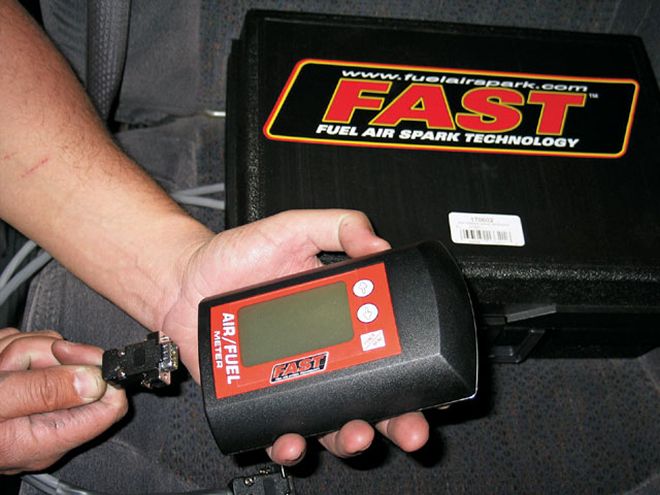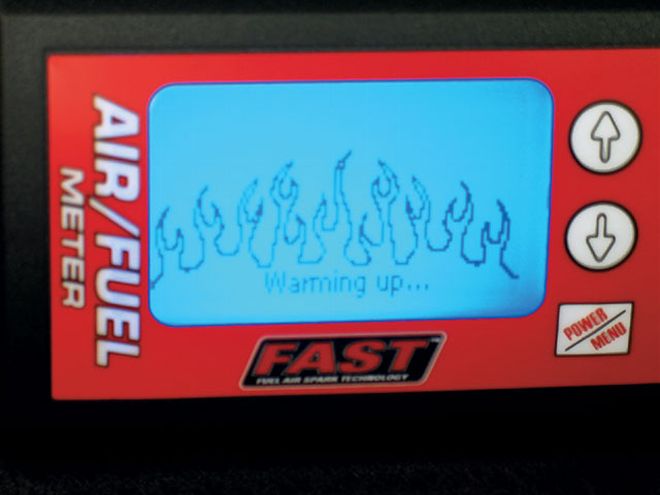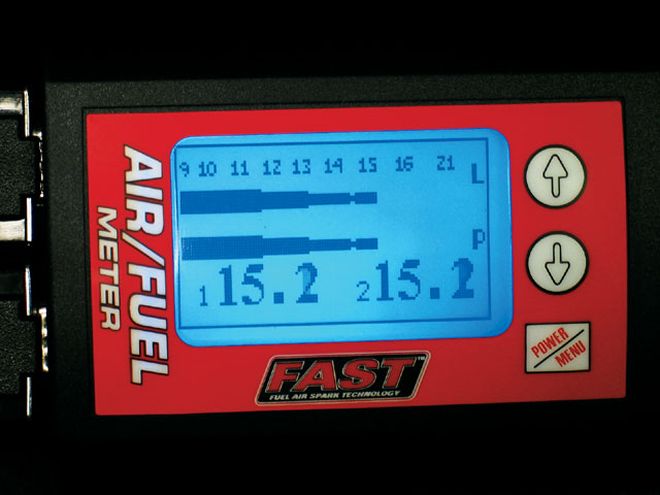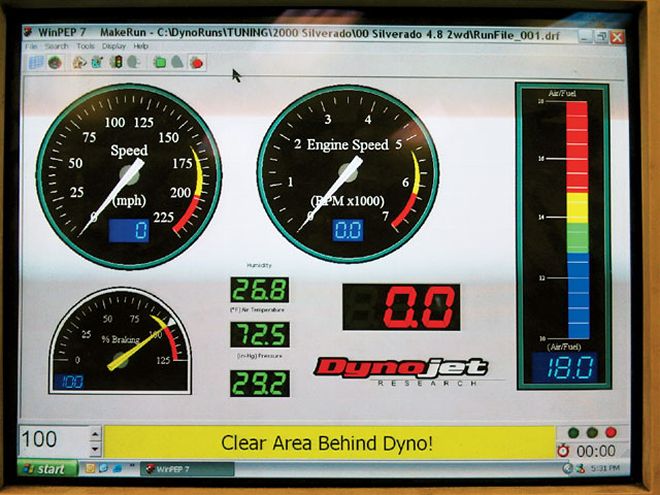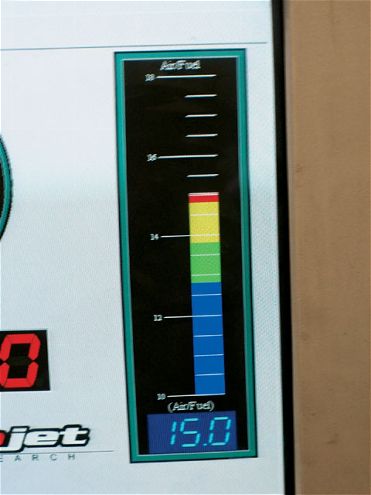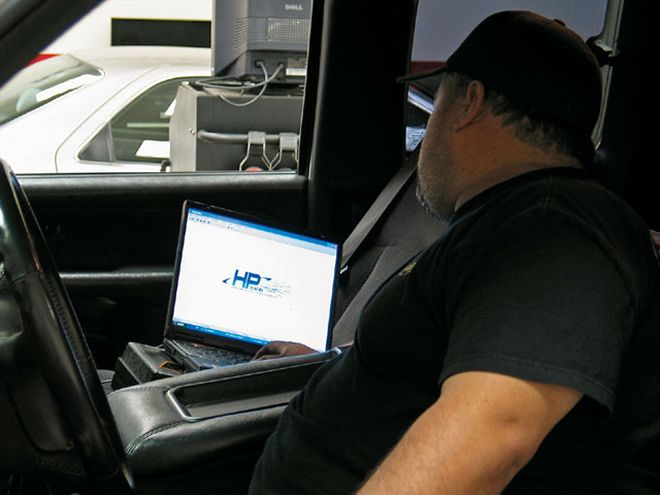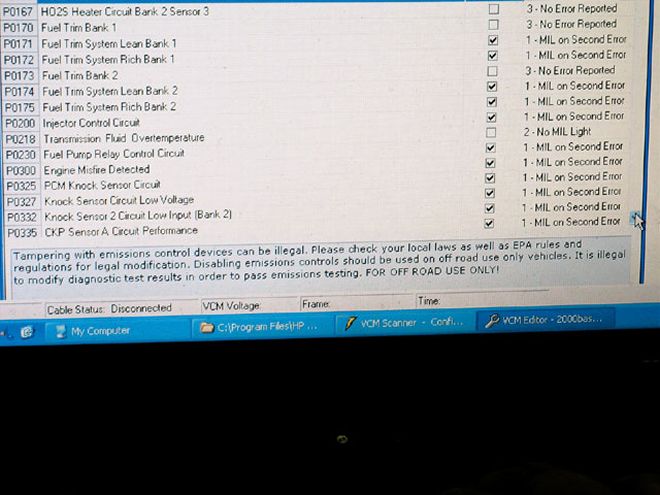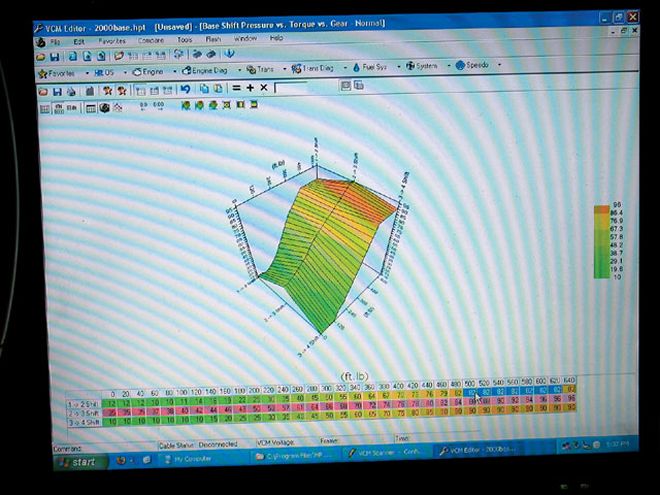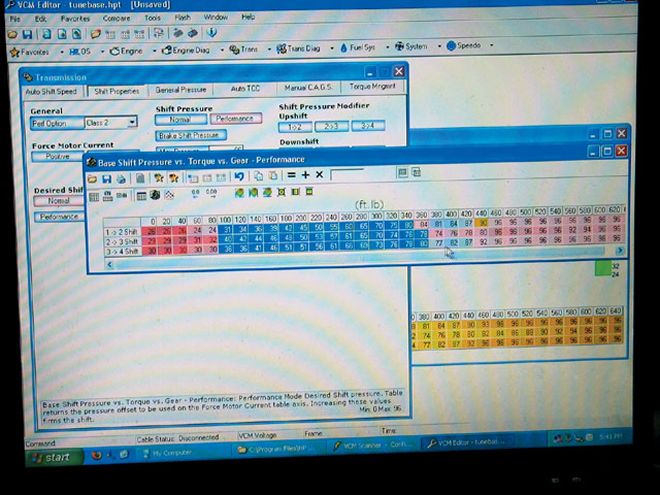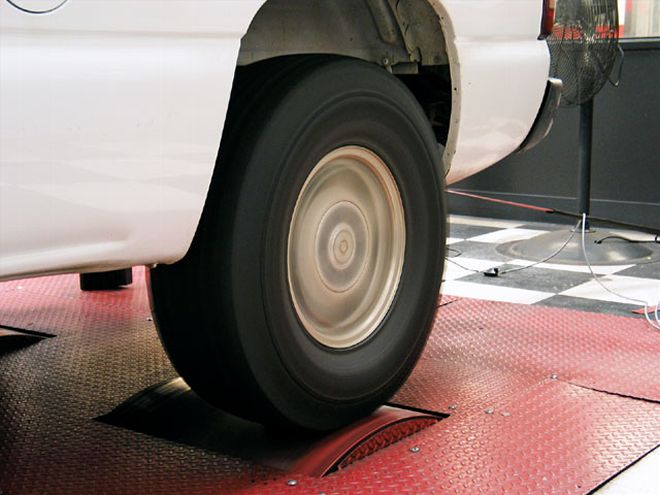Maximum engine performance requires proper tuning. Until recently, engine tuners were only able to monitor one side of the engine during tuning, or both sides out of the tailpipe in a mixed configuration. With the Fuel Air Spark Technology (FAST) new Dual Sensor Air/Fuel Meter, tuners now have the edge they need to expedite tuning parameters. FAST developed an easy to use system that delivers the complete story about your engine's tuning. Two wide-band O2 sensors individually read and display each engine bank's measurements, which can be either displayed on the built-in screen or recorded and data logged for later use.
AFR is an important measure for anti-pollution and performance tuning. First, we should give you an explanation of what the air/fuel ratio is and why it's important. Air/fuel ratio (AFR) is simply the mass ratio of air to fuel present during combustion. When all of the fuel is combined with all of the oxygen, the mixture is chemically balanced and is called the stoichiometric mixture (abbreviated to stoich). A stoich mixture is the working point that modern EFI engine management systems attempt to achieve in light-load cruise situations. For gasoline engines, the stoichiometric mixture is approximately 14.7 to 1, which translates into 14.7 parts of air to every 1 part of fuel. Any less air and the mixture is considered "rich," whereas any more and the ratio is "lean."
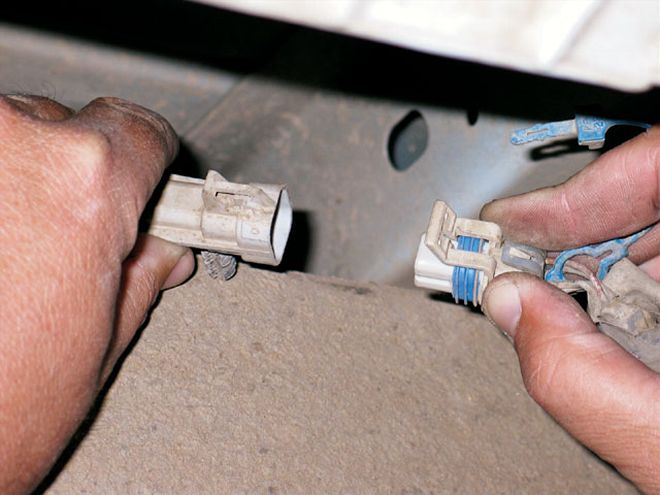
| With the truck safely on a hydraulic hoist, we started by disconnecting the rear O2 sensors' factory harnesses, then removed the sensors from the exhaust. Normally, you would choose to weld in the bungs in front of the catalytic converters because they skew the readings. But, in our case the converters were wiped out, thanks to crazy A/F ratios. Dynatech will have sent us replacements by the time this article sees print.
In a perfect world, with perfect fuel, the numbers will correlate. But in our world, there is some translation. In reality, most fuels consist of a combination of heptane, octane, a handful of other alkanes, plus other detergents, and possibly oxygenators such as MTBE or ethanol/methanol. These compounds alter the stoich ratio down as low as 14.1 to 1. Vehicles using an oxygen sensor will usually compensate automatically for this change by sampling the exhaust composition and adjusting as necessary. With the FAST system measuring each of the engine's banks individually, tuners can be 100-percent positive of all readings and adjust as necessary for maximum and proper performance, no matter which fuel is used.
With that information in mind, as well as the current state of affairs with gas prices, we sought the expertise of tuner Richard Waitas. We last featured our workhorse Silverado in Volume 32, No. 10 in "Full-Length Boogie," on page 124. In that tech story, we installed Dynatech full-length headers, a Dynatech Y-pipe with catalytic converters, and a MagnaFlow after-cat exhaust system. With a ton of hard-earned miles underneath its hood, the Chevy still belted out 248.7 hp and 255.21 lb-ft of torque on 91-octane with a hand-held programmer. Over time, the engine has held up quite well, but under certain conditions it just did not run correctly. Occasionally, it would even lean pop when shifting gears under full-throttle conditions. Not good. We reset the computer back to factory and handed the truck to Richard Waitas for an across-the-board tune, by utilizing a laptop computer and HP Tuners software. Our wrench in the situation was that we wanted to get away from the high cost of 91-octane fuel and only run 87-octane. Could Richard make our 4.8L run correctly with 87-octane and still make close to the same power we were making? Follow along as we watched Richard tune our truck using the FAST's Dual Meter A/F monitor.
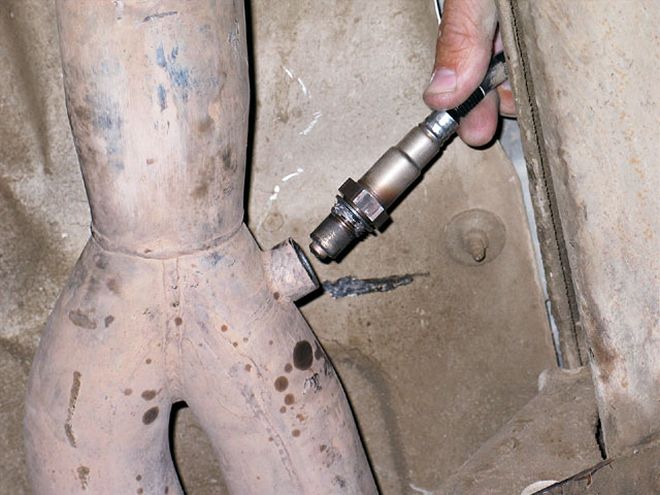
| With the rear O2 sensors out of the way, it was a simple matter of replacing them with the supplied FAST sensors. They simply thread in, as they are all standardized threads.
This truck runs like a whole different animal. The lean pop under full-throttle upshifts is gone, and the tendency to run into the rev limiter during up shifts is gone, too. With FAST's Dual Monitor, Richard was able to watch the engine and monitor it every step of the way to make adjustments as needed. Power across the board has been increased, along with a healthy dose of torque. You may wonder why our peak numbers are so exciting to us-as they barely beat out our prior numbers. We'll recap for you. The truck was originally tested with a hand-held programmer set for 91-octane tuning. Our new tuning is for 87-octane fuel and we still made more power. Not just peak, but across the board. Our peak numbers were better by 3.07 hp and 9.6 lb-ft of torque, but that was well up the rpm scale where normal driving duties don't necessarily go. The big news is what's commonly referred to as the "area under the curve." Down at 3,000 rpm-where normal street shifting occurs during casual driving-our 4.8L was making 20 hp and 30 lb-ft of torque more than before. This is due to the HP Tuners software's ability to make incremental changes. We think those numbers are huge in comparison and our daily grind with that truck is much improved. We now have more power, better shifting, good gas mileage, and we're paying less at the pump for the pleasure. That's something to be excited about.
YOUR QUESTIONS ANSWERED Time Spent Working Approximately 4 hours Degree of Difficulty Advanced (Extensive knowledge of EFI engine management is necessary for tuning) Tools Needed: Basic handtools
PARTS USED: • FAST PN 170402 Dual Sensor A/F Meter MSRP $629.93 • HP Tuners VCM Suite MSRP $649.00 • Richard Waitas Tuning MSRP price varies by application. Total Cost: $1,278.93 (Not including tuning costs, tax, or installation labor)
 | With the truck safely on a hydraulic hoist, we started by disconnecting the rear O2 sensors' factory harnesses, then removed the sensors from the exhaust. Normally, you would choose to weld in the bungs in front of the catalytic converters because they skew the readings. But, in our case the converters were wiped out, thanks to crazy A/F ratios. Dynatech will have sent us replacements by the time this article sees print.
In a perfect world, with perfect fuel, the numbers will correlate. But in our world, there is some translation. In reality, most fuels consist of a combination of heptane, octane, a handful of other alkanes, plus other detergents, and possibly oxygenators such as MTBE or ethanol/methanol. These compounds alter the stoich ratio down as low as 14.1 to 1. Vehicles using an oxygen sensor will usually compensate automatically for this change by sampling the exhaust composition and adjusting as necessary. With the FAST system measuring each of the engine's banks individually, tuners can be 100-percent positive of all readings and adjust as necessary for maximum and proper performance, no matter which fuel is used.
With that information in mind, as well as the current state of affairs with gas prices, we sought the expertise of tuner Richard Waitas. We last featured our workhorse Silverado in Volume 32, No. 10 in "Full-Length Boogie," on page 124. In that tech story, we installed Dynatech full-length headers, a Dynatech Y-pipe with catalytic converters, and a MagnaFlow after-cat exhaust system. With a ton of hard-earned miles underneath its hood, the Chevy still belted out 248.7 hp and 255.21 lb-ft of torque on 91-octane with a hand-held programmer. Over time, the engine has held up quite well, but under certain conditions it just did not run correctly. Occasionally, it would even lean pop when shifting gears under full-throttle conditions. Not good. We reset the computer back to factory and handed the truck to Richard Waitas for an across-the-board tune, by utilizing a laptop computer and HP Tuners software. Our wrench in the situation was that we wanted to get away from the high cost of 91-octane fuel and only run 87-octane. Could Richard make our 4.8L run correctly with 87-octane and still make close to the same power we were making? Follow along as we watched Richard tune our truck using the FAST's Dual Meter A/F monitor.
| With the truck safely on a hydraulic hoist, we started by disconnecting the rear O2 sensors' factory harnesses, then removed the sensors from the exhaust. Normally, you would choose to weld in the bungs in front of the catalytic converters because they skew the readings. But, in our case the converters were wiped out, thanks to crazy A/F ratios. Dynatech will have sent us replacements by the time this article sees print.
In a perfect world, with perfect fuel, the numbers will correlate. But in our world, there is some translation. In reality, most fuels consist of a combination of heptane, octane, a handful of other alkanes, plus other detergents, and possibly oxygenators such as MTBE or ethanol/methanol. These compounds alter the stoich ratio down as low as 14.1 to 1. Vehicles using an oxygen sensor will usually compensate automatically for this change by sampling the exhaust composition and adjusting as necessary. With the FAST system measuring each of the engine's banks individually, tuners can be 100-percent positive of all readings and adjust as necessary for maximum and proper performance, no matter which fuel is used.
With that information in mind, as well as the current state of affairs with gas prices, we sought the expertise of tuner Richard Waitas. We last featured our workhorse Silverado in Volume 32, No. 10 in "Full-Length Boogie," on page 124. In that tech story, we installed Dynatech full-length headers, a Dynatech Y-pipe with catalytic converters, and a MagnaFlow after-cat exhaust system. With a ton of hard-earned miles underneath its hood, the Chevy still belted out 248.7 hp and 255.21 lb-ft of torque on 91-octane with a hand-held programmer. Over time, the engine has held up quite well, but under certain conditions it just did not run correctly. Occasionally, it would even lean pop when shifting gears under full-throttle conditions. Not good. We reset the computer back to factory and handed the truck to Richard Waitas for an across-the-board tune, by utilizing a laptop computer and HP Tuners software. Our wrench in the situation was that we wanted to get away from the high cost of 91-octane fuel and only run 87-octane. Could Richard make our 4.8L run correctly with 87-octane and still make close to the same power we were making? Follow along as we watched Richard tune our truck using the FAST's Dual Meter A/F monitor.
 | With the rear O2 sensors out of the way, it was a simple matter of replacing them with the supplied FAST sensors. They simply thread in, as they are all standardized threads.
This truck runs like a whole different animal. The lean pop under full-throttle upshifts is gone, and the tendency to run into the rev limiter during up shifts is gone, too. With FAST's Dual Monitor, Richard was able to watch the engine and monitor it every step of the way to make adjustments as needed. Power across the board has been increased, along with a healthy dose of torque. You may wonder why our peak numbers are so exciting to us-as they barely beat out our prior numbers. We'll recap for you. The truck was originally tested with a hand-held programmer set for 91-octane tuning. Our new tuning is for 87-octane fuel and we still made more power. Not just peak, but across the board. Our peak numbers were better by 3.07 hp and 9.6 lb-ft of torque, but that was well up the rpm scale where normal driving duties don't necessarily go. The big news is what's commonly referred to as the "area under the curve." Down at 3,000 rpm-where normal street shifting occurs during casual driving-our 4.8L was making 20 hp and 30 lb-ft of torque more than before. This is due to the HP Tuners software's ability to make incremental changes. We think those numbers are huge in comparison and our daily grind with that truck is much improved. We now have more power, better shifting, good gas mileage, and we're paying less at the pump for the pleasure. That's something to be excited about.
| With the rear O2 sensors out of the way, it was a simple matter of replacing them with the supplied FAST sensors. They simply thread in, as they are all standardized threads.
This truck runs like a whole different animal. The lean pop under full-throttle upshifts is gone, and the tendency to run into the rev limiter during up shifts is gone, too. With FAST's Dual Monitor, Richard was able to watch the engine and monitor it every step of the way to make adjustments as needed. Power across the board has been increased, along with a healthy dose of torque. You may wonder why our peak numbers are so exciting to us-as they barely beat out our prior numbers. We'll recap for you. The truck was originally tested with a hand-held programmer set for 91-octane tuning. Our new tuning is for 87-octane fuel and we still made more power. Not just peak, but across the board. Our peak numbers were better by 3.07 hp and 9.6 lb-ft of torque, but that was well up the rpm scale where normal driving duties don't necessarily go. The big news is what's commonly referred to as the "area under the curve." Down at 3,000 rpm-where normal street shifting occurs during casual driving-our 4.8L was making 20 hp and 30 lb-ft of torque more than before. This is due to the HP Tuners software's ability to make incremental changes. We think those numbers are huge in comparison and our daily grind with that truck is much improved. We now have more power, better shifting, good gas mileage, and we're paying less at the pump for the pleasure. That's something to be excited about.

